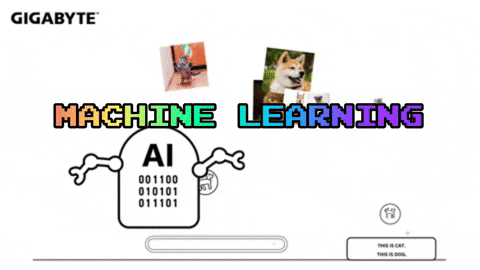- Published on
How Do Machines Learn? A Beginner-Friendly Breakdown
- Authors

- Name
- Nguyen Phuc Cuong
Introduction
In my previous post, I shared an overview of AI and how to start learning AI in 2025. Today, as we continue this series, let's dive deeper into the AI world and explore a fundamental concept.
Have you ever wondered why your phone's camera can recognize your face, or how Gmail automatically sorts spam emails? The answer lies in machine learning – but what does that actually mean?
Think of it like teaching a child to distinguish between cats and dogs. Parents show real-world examples, pointing out the differences until the child learns to identify them independently. Machine learning works similarly – we provide as many examples as possible during training, allowing the system to predict results based on vast amounts of data.
A perfect example of this is handwriting recognition applications, where machines learn to read different handwriting styles by analyzing thousands of writing samples.
Machine Learning is the science (and art) of programming computers so they can learn from data
— Aurélien Géron

Types of Machine Learning
Let's break down the three main types in simple terms:
Supervised Learning
The machine learns from labeled data, like teaching it to identify "spam" or "not spam" emails by showing thousands of pre-labeled examples.

Example: Email spam detection, medical diagnosis systems, image classification
Unsupervised Learning
The system finds hidden patterns in data without being given specific labels, like discovering customer groups based on purchasing behavior.

Example: Customer segmentation, recommendation systems, market research analysis
Reinforcement Learning
The machine learns through trial and error, receiving rewards for correct actions and penalties for mistakes – similar to training a pet or learning to play a game.

Example: Game-playing AI (like AlphaGo), autonomous vehicles, chatbot optimization
Real-World Machine Learning Applications
You interact with machine learning more often than you might think:
- Social media feeds: Algorithms decide which posts you see first
- Autonomous vehicles: Self-driving cars navigate using ML algorithms
- Email filtering: Automatic spam detection and organization
- Voice assistants: Siri, Alexa, and Google Assistant understand your commands
- Streaming services: Netflix and Spotify recommendations
- E-commerce: Product suggestions on Amazon and other platforms
Let's dive deeper in an example
Challenge: Predicting Home Values
Step 1: Import Libraries
import pandas as pd
from sklearn.linear_model import LinearRegression
from sklearn.model_selection import train_test_split
from matplotlib import pyplot as plt
What's happening here?
pandas- Think of this as Excel for Python. It helps us organize data in tablesLinearRegression- This is our AI "brain" that will learn to predict house pricestrain_test_split- A helper that splits our data into "study material" and "exam questions"matplotlib- For creating charts and graphs (like making a presentation)
Step 2: Create Sample Data (Our House Examples)
# Sample house data
data = {
'bedrooms': [2, 3, 4, 2, 3, 4, 5, 3, 2, 4],
'bathrooms': [1, 2, 3, 1, 2, 2, 3, 2, 1, 3],
'sqft': [1000, 1500, 2000, 900, 1200, 1800, 2500, 1400, 800, 2200],
'price': [200000, 300000, 400000, 180000, 250000, 350000, 500000, 280000, 150000, 420000]
}
What's happening here?
- We're creating a dictionary (like a filing cabinet) with 4 categories
- Each list contains 10 examples of houses with their features
bedrooms- How many bedrooms each house hasbathrooms- How many bathrooms each house hassqft- Square footage (house size)price- What each house actually sold for
Step 3: Convert Data to DataFrame (Organize Like a Spreadsheet)
df = pd.DataFrame(data)
What it looks like:
bedrooms bathrooms sqft price
0 2 1 1000 200000
1 3 2 1500 300000
2 4 3 2000 400000
...
Step 4: Separate Features and Target (Input vs Output)
# Features (input) and target (output)
X = df[['bedrooms', 'bathrooms', 'sqft']]
y = df['price']
What's happening here?
X(features) = What we KNOW about a house (bedrooms, bathrooms, size)y(target) = What we want to PREDICT (the price)
Real-world analogy:
X= The house description you show to a real estate agenty= The price estimate they give you back
Why this separation?
- The machine needs to learn: "When I see these features (X), the price should be (y)"
- It's like teaching a child: "When you see these clues, this is the answer"
Step 5: Split Data for Training and Testing (Study vs Exam)
# Split data into training and testing sets
X_train, X_test, y_train, y_test = train_test_split(X, y, test_size=0.2, random_state=42)
What's happening here?
test_size=0.2means 20% for testing, 80% for trainingrandom_state=42ensures we get the same split every time (for consistency)
Step 6: Create the AI Model (Build the Brain)
# Create and train the model
model = LinearRegression()
model.fit(X_train, y_train)
What's happening here?
LinearRegression()creates an empty "brain" that can learn patternsmodel.fit()is like the "learning" phase - it studies the training data
Step 7: Make a Prediction (Test the AI)
# Make predictions
new_house = pd.DataFrame([[3, 2, 1600]], columns=['bedrooms', 'bathrooms', 'sqft'])
predictions = model.predict(new_house)
What's happening here?
- We create a new house with 3 bedrooms, 2 bathrooms, and 1600 sqft
model.predict()asks our trained AI: "What do you think this house costs?"- The AI uses what it learned to give us an estimated price
Step 8: Display the Results (Show the Answer)
print(f"House with 3 bedrooms, 2 bathrooms, 1600 sqft")
print(f"Predicted price: ${predictions[0]:,.2f}")
Step 9: Check Model Accuracy (How Good Is Our AI?)
# Show accuracy
accuracy = model.score(X_test, y_test)
print(f"Model accuracy: {accuracy:.2f}")
What we got
Run python your-code.py, you will got the result like this:
House with 3 bedrooms, 2 bathrooms, 1600 sqft
Predicted price: $311,844.96
Model accuracy: 0.98
Final thoughts
- Machine learning isn't magic – it's all about data. The more quality data you have, the more accurate your results
- Understanding these fundamentals is the best foundation for diving deeper into your AI journey
- Every AI application you use daily relies on these core machine learning principles
Ready to explore more AI concepts? Follow along as we continue this journey into the fascinating world of artificial intelligence!